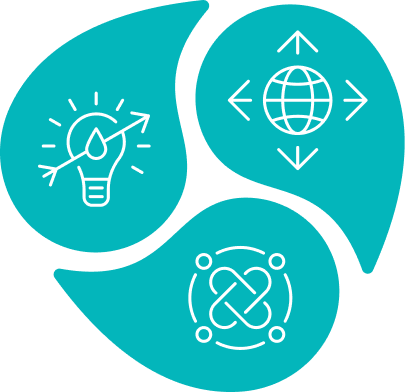Water is a source of conflict around the Berki River Basin in Ethiopia, predominantly a consequence of a lack of IWRM awareness and an institutional framework. Action was taken to implement an IWRM pilot project to account for different stakeholder interests, resulting in the adoption of the Berki Basin IWRM. Lessons learned include the importance of capacity building, consensus building, and the importance of decentralised multi-stakeholder platforms for conflict management.
Background
The Berki River originates in the highlands of Tigray (north Ethiopia) and flows to join Giba River, a tributary of the river Tekeze, which ultimately joins the Nile. The Berki watershed is shared by three districts (“Woredas”), namely Atsbi at the upstream and Wukro and Enderta at the downstream. The size of the catchment is about 410 km2. Hydrological conditions and ecosystem of the area are threatened by agricultural activities, fuel wood collection and free animal grazing.
Farmers in the upper Berki catchment use pumps to take water from the river and there was a plan to introduce 100 more pumps which might negatively impact irrigation activities downstream sites. There are already three diversions of streams that irrigate more than 150 ha. Moreover, there is a spring near Berki diversion that is used by the Church for spiritual purposes (holy water).
The full control of the Church who anticipated that the government would develop it to supply water to the Agula town caused a conflict with the Bureau of Water Resources of the Tigray Regional State. Moreover, a conflict between the downstream traditional irrigation water users and upstream Laelay Agula diversion water users, resulted in the destruction of the diversion weir by the downstream users.
This illustrates that water is the scarcest resource in the Berki basin and a cause of conflicts among up and downstream communities; the administrative authorities; and local businesses and NGOs. The root cause of the complex challenge is a low level of IWRM awareness and the lack of institutional framework for stakeholders’ participation.
Actions taken
Initiated by Ethiopian Country Water Partnership (ECWP) and GWP Eastern Africa, with support from the US Department of State (USDoS), an IWRM pilot project was implemented during 2006-2008. This was envisaged as a mechanism for a holistic approach that takes care of varied interests of the different stakeholders in the Woredas.
The main objective was to establish framework and to promote application of IWRM with interventions involving multi-stakeholder participatory planning at the catchment level. They also included capacity building and awareness raising activities. The following three features (components) blended the actions:
- Partnership building and mobilization of stakeholders participation in IWRM processes
- Water demand management grounded in water resources assessment
- Application of conflict resolution tools in IWRM processes.
Specifically the following approach was followed by the project:
- Identify policy gaps and constraints in implementing IWRM;
- Identify stakeholders in water resources management of the Tigray regional state;
- Sensitize stakeholders in Tigray on IWRM principles and approaches;
- Launch the Tigray Regional Water Partnership (TRWP);
- Establish a Tigray Regional Technical Team from various disciplines and sectors;
- Train a technical team;
- Assess the water and other natural resources of the Berki watershed;
- Study the socio-economic dynamics of the Berki watershed;
- Establish Wereda Watershed Committees;
- Establish an Inter-Wereda Watershed Committee;
- Document and share experiences on approaches, processes and findings at various levels by sharing information and partnership meetings.
Note that there were continuous training, awareness raising, and consultation programmes among all stakeholders at various levels.
Outcomes
A combination of both water supply and demand management was found to be the appropriate approach to address the grave social and economic problems of the Berki basin. The project resulted in development and adoption of the Berki Basin IWRM Plan with the concrete measures ranging from legal, institutional, financial to technical measures.
Value added of the participatory approach is that communities are now better aware of the water resources management issues, and they understand implications of their practices on others.
The existence of the partnerships also challenges long-held ideas and practices entrenched in linear planning and single agency responsibility in the region and at the watershed level. The establishment of multi-stakeholder forums at the regional, Berki and wereda levels has given the opportunity for interaction among various stakeholders. This is also providing an opportunity to lay a framework for integrating/coordinating activities by various sectors/stakeholders.
As a result of the establishment of the multi-stakeholder platforms and the various stakeholders’ consultations, water-related disputes and conflicts have been minimized. There is now recognition of the importance of the multi-stakeholder partnerships at the local level and working together is viewed as a way to resolve water issues at the local level. For example, two key conflicts in the catchment were resolved without any legal or administrative intervention.
Although most stakeholders at federal and regional levels do recognize the difficulty in harmonizing administrative and hydrological boundaries, in Berki the catchment is considered a management unit despite the administrative boundaries. An integrated watershed development and management plan has already been prepared for Berki, and NGOs and government bodies have committed to implement the plan as part of their regular development programme within the partnership framework.
Lessons Learned
Consensus building and decision support systems are useful tools of conflict management and could be widely applied. Decentralized participatory multi-stakeholder platforms are key instruments for conflict management. Consensus building is essential component of IWRM implementation.
Capacity building activities (training courses, workshops, dialogues) should be embedded in each IWRM project.
Understanding the water resource potential and socio-economic dynamics in the basis establishes the basis for better decision making.

 Case study
Case study